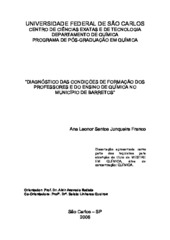Diagnóstico das condições de formação dos professores e do ensino de Química no município de Barretos.
Abstract
This work presents a descriptive and analytic study on chemical education in Barretos
(São Paulo). The purpose of the study is mainly to investigate the pedagogic practices in
secondary and higher chemistry education and suggest possible intervention strategies. The
methodology involved three types of questionnaires: one completed by secondary chemistry
teachers, one by undergraduate professors, and one by undergraduate students. The teacher
and professor questionnaires asked teachers and professors to provide information about their
own education and experience, the resources available to them, subject implementation and
classroom practices, and student evaluation. The student questionnaire asked students a
variety of questions about themselves, professors' classroom practices, and the resources
available to them. Various instructional practices are not used by secondary teachers and
professors. Lectures to the whole class are prevalent in both grades. Text-based and centred
approaches are the most common practices. This is of great concern in an issues-based world
where science and technology have so much impact on society. Using current science-related
issues as an integral part of the chemistry course should be strengthened. The students must
be capable of discussing, responding to, and acting upon issues as young citizens in our
society. The vast majority of secondary teachers reported that equipment and lab facilities are
not available. The situation with respect to higher education is better but still far from
satisfactory. Professors and undergraduate students reported that the quantity of lab materials,
computers, and library materials is insufficient. This situation should be rectified before the
cost of updating and replacing the learning resources for chemistry is impossible to achieve.
Tests, supplemented by lab assignments, are the heaviest weighted information source for
student evaluation in both grades, although they form a larger portion of students' evaluation.
Too little emphasis has been placed on alternate evaluation approaches. Steps should be taken
to improve on the variety of appraisal practices at the secondary and tertiary level, and
teachers and professors should be assisted in developing their own approaches to evaluation.
